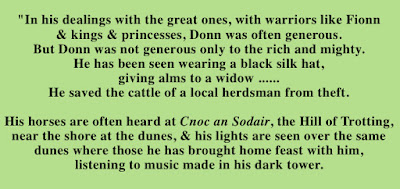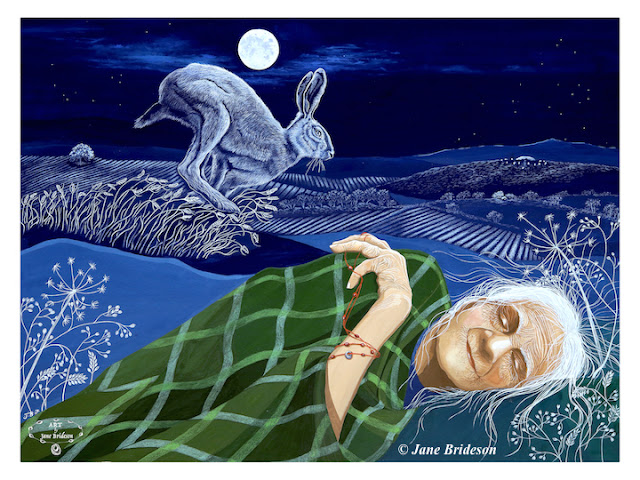As 2017 passes I look back at the year's adventures.
The darkness of winter was illuminated by the magical work of Harry Clarke.
‘He might have incarnated here from the dark side of the moon …
Harry Clarke is one of the strangest geniuses of his time’
- George AE Russell
To read 'A Dark Beauty' click HERE
*
As Imbolg approached I left the hearth and visited Croghan Hill in search of Brigid's Well.
“ There were two St Brigids.
There was St Brigid up in Kildare, but this is the Brigid from this place.”
To read 'Searching for Brigid's Well' click HERE
*
In February I stepped upon the Stray Sod.
"The Stray Sod appears in Irish folk belief and is explained as a clump of grass, slightly greener than its’ neighbours, which has strayed from the Otherworld into this world.
Stepping upon the Sod brings a sudden feeling of inexplicable disorientation."
*
A new painting emerged and a tale from the Cailleach for Spring Equinox.
"At the mound, breath hoar frost on stone, I enter black stillness.
In this womb, the air, already laden with the scent of meadowsweet yet to bloom,
shifts as I trace shapes within the stones.
Patterns once danced upon the land in rhythm with earth, sea and sky."
To read 'The Cailleach tips the Balance' click HERE
*
As the sun shone I travelled further afield to discover the untouched beauty of Meehambee Dolmen.
"Entranced by stones, sunshine and the scent of ramsons,
I thought of the time-worn rituals of burying and honouring the dead.
Who were the people who stood here? What were their customs?
Did they mourn or celebrate the passing of their own into another life?"
To read 'Walking the Path of the Ancestors' click HERE
*
Bealtaine arrived and I made my offerings, entranced by water.
"On May Day, the start of summer, especially in the moments before dawn,
water was understood to possess magical qualities
and in rural Ireland the Good People used this medium to meddle in the affairs of humans."
To read 'Bealtaine, Water & Sun-Enchanted Dew' click HERE
*
In May whitethorn blossom covered the landscape.
"Standing between this world and the Otherworld the whitethorn, An Sceach Gheal,
‘bright, shining thorn’, is steeped in folklore
and regarded with respect for fear of supernatural retribution."
To read 'Whitethorn - on the Threshold of the Otherworld' click HERE
*
As summer progressed the goddess Áine summoned me to Knockainey.
"The landscape holds its’ secrets but still whispers, in the summer months,
of forgotten rituals, celebrations to the sun and to Áine,
the “ beautiful spirit crowned with meadowsweet”."
To read 'Knockainey, Midsummer and the scent of Meadowsweet' click HERE
*
My annual visit to The Burren brought the scents of summer and a brush with Themselves.
"St. John’s Eve had not long passed, the air on the Slieve Aughty mountains was warm
and along the way the foxgloves bloomed, a portent of what was to come."
To read 'Meeting the Othercrowd in a Scented Land' click HERE
*
I gathered fraochans and folklore at Lughnasadh.
"Bilberry pies called Pócai Hócai, were made by young women to be presented to their
chosen partners and fraochan wine, a mixture of sugar and berry juice,
was given to lovers in the hope of hastening a wedding."
To read 'Gathering Fraochans at Brón Trogain' click HERE
*
Paddy finds the Mysterious Stone.
To read 'The Mysterious Stone' click HERE
*
In September I completed a new painting "The Morrigan Rises".
"Much later, one Samhain sunset, eyes open in trance, I saw her cave beneath the naked thorn."
To read 'Glimpsing The Morrigan' click HERE
*
Driving through the Blackstairs mountains in October chance brought me to a sacred well.
" I had stumbled upon Tobar Cranabhán, the Well of the White Tree, a ritual site and holy well.
Tradition tells that it was once the site of pre-Christian ceremonies
associated with druids and aligned to the sun."
To read 'At the Well of the White Tree' click HERE
*
Samhain brought a second tale from The Cailleach.
"At times my hare-shape, spied amongst the stalks, caused old ones to make the sign
and murmur against ill-wishing.
They recognised my power."
To read 'Tales from The Cailleach: Into A Hare" click HERE
*
The darkness deepened and Donn Fírinne haunted my imagination.
*
On December 24th, The Cailleach returned with an old tradition.
"Below a thousand candles burn in windows to welcome the weary."
To read ' A million stars, A thousand Candles' click HERE
***
And now the sun has come full circle and though the nights are still long
I look forward to another year.
Who knows what awaits me?


























































